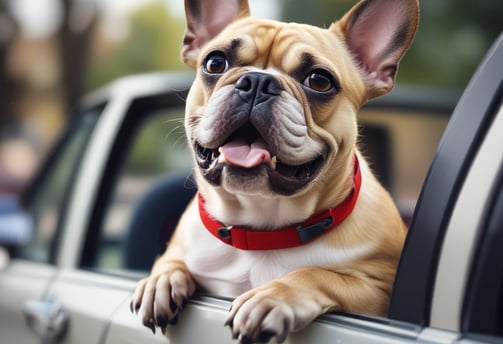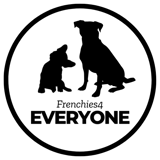Some Basic Care Information
Discover the best practices for caring for French Bulldogs and other dogs. Learn about their dietary needs, exercise routines, playtime activities, and medical care. Understand how much love and attention they require to thrive and be happy companions in your life.
5/8/20245 min read


We've partnered with Chewy and The Online Dog Trainer. Click here to shop and support the site:
Chewy: https://prf.hn/l/y8k9Wjm/
The Online Dog Trainer: bit.ly/3Cz2y4B
Breathing Problems in Bulldogs: An Overview
Bulldogs are distinctly known for their brachycephalic features, characterized by a short snout and a flat face. This anatomical structure, while contributing to their unique appearance, predisposes them to several breathing problems. One of the most prevalent issues faced by bulldog breeds is brachycephalic obstructive airway syndrome (BOAS). This condition is caused by the anatomical abnormalities of the upper respiratory tract, which can manifest in varying degrees of severity. BOAS leads to a cascade of complications, including severe exercise intolerance, increased respiratory effort, and even life-threatening situations in extreme cases.
The brachycephalic structure of bulldogs results not only in a narrowed nostril but also in an elongated soft palate which can obstruct the airway. The limited airflow can cause obstructive symptoms such as snorting, snoring, and reverse sneezing. Reverse sneezing, often alarming for pet owners, is characterized by sudden inhalation through the nose, which can resemble choking. However, it is typically a harmless reflex that occurs when the dog tries to clear irritants from its throat or nasal passages. Although it may appear distressing, understanding this behavior is crucial for bulldog owners.
Genetic predispositions also play a role in the respiratory issues experienced by bulldogs. Selective breeding practices aimed at enhancing certain physical traits have unfortunately led to a higher prevalence of breathing difficulties. This has broad implications for their general well-being and quality of life. Owners should be particularly vigilant about potential symptoms and ensure regular veterinary check-ups for early detection of respiratory issues. Understanding these unique challenges bulldogs face is essential for anyone considering bringing this breed into their home, as proper care and management can greatly enhance their overall health and comfort.
Understanding Reverse Sneezing: What It Is and Why It Happens
Reverse sneezing is a common phenomenon observed in bulldogs and other brachycephalic breeds, characterized by a series of rapid inhalations through the nose, often causing a distinctive honking sound. This reflex differs from typical sneezing, which expels air forcefully through the mouth and nose, usually triggered by irritants in the nasal passages. In contrast, reverse sneezing involves a spasm in the throat and soft palate, leading to a temporary inability to breathe normally.
The causes of reverse sneezing can be multifaceted. One significant trigger includes environmental factors such as dust, pollen, or strong odors that can irritate the respiratory system. Additionally, allergies play a substantial role; many bulldogs are prone to allergic reactions that may exacerbate breathing difficulties. Excitement or rapid changes in activity levels, such as sudden bursts of play, can also provoke episodes of reverse sneezing. Understanding these triggers can help pet owners identify and mitigate the causes of this phenomenon, ensuring that their bulldogs remain comfortable.
Despite the alarming sound, reverse sneezing is generally considered benign and not inherently dangerous to a bulldog's health. Episodes may vary in frequency and intensity, but in most cases, they are self-limiting and resolve quickly without medical intervention. Monitoring the situation is essential; however, dog owners should take note of any changes in the frequency or severity of episodes, as an increase could indicate underlying health concerns such as respiratory infections or more significant allergies. In such situations, consulting a veterinarian is advisable to rule out serious issues and receive appropriate advice. Recognizing reverse sneezing as a normal behavior in bulldogs can alleviate concerns while fostering a deeper understanding of this unique respiratory phenomenon.
Helping Your Frenchie Through Reverse Sneezing Attacks
Reverse sneezing is a common phenomenon observed in breeds such as French Bulldogs, often causing concern among pet owners. It usually manifests as a series of rapid inhalations, which may sound alarming but is generally harmless. Understanding how to help your Frenchie during these episodes is crucial for ensuring their comfort and well-being.
One of the first steps in assisting your dog is to remain calm. Your pet is highly attuned to your emotions; by projecting a sense of tranquility, you can help ease their anxiety. Speaking softly and reassuringly can also be beneficial. During a reverse sneezing episode, take a moment to observe and assess the situation before intervening. Most episodes will resolve on their own, lasting only a few seconds to a few minutes.
To further alleviate the discomfort, gently massaging your dog’s throat can often provide relief. This motion may help to clear any irritation causing the episode and assist in soothing your Frenchie. Additionally, gently covering your dog’s nostrils with your fingers for a brief moment can encourage them to swallow, which typically interrupts the reverse sneezing pattern.
It is also essential to recognize the signs that may indicate a need for veterinary attention. If you notice your French Bulldog reverse sneezing frequently or exhibiting other concerning symptoms such as difficulty breathing, coughing, or lethargy, it would be wise to consult with a veterinarian. Persistent reverse sneezing can indicate underlying issues such as allergies or respiratory conditions that require further evaluation.
In conclusion, being proactive and aware of your pet’s reactions during reverse sneezing can make a significant difference. By employing calming techniques and knowing when to seek professional help, you can enhance your Frenchie’s comfort during these episodes, ensuring their health and happiness are prioritized. Remember that your response can influence your dog's stress levels, making your calm demeanor an invaluable asset in offering support.
Safe Exercise and Play for Your French Bulldog
Ensuring that your French Bulldog remains active while prioritizing their health is essential. Due to their unique respiratory structure, engaging in safe exercise practices becomes a necessity to prevent overexertion and breathing issues. It is important to choose exercises that align with their physical capabilities. Short and moderate walks are often preferred over extended runs, as they reduce the risk of respiratory distress.
In addition to walks, engaging in low-impact activities such as gentle fetch games or controlled play sessions can provide both physical and mental stimulation. However, it is crucial to monitor your French Bulldog's behavior during these activities. Signs of fatigue, such as excessive panting, reluctance to continue playing, or seeking shade or cooler areas, should be closely observed. These indicators may suggest that it is time to pause or conclude the session to prevent undue stress on their respiratory system.
Creating a safe play environment is equally important. Ensure that the play area is free from hazards such as sharp objects or hot surfaces that may injure your dog. Opt for soft, comfortable surfaces like grass instead of rough or hot pavement, which can be distressing for your French Bulldog's paws and overall comfort. Additionally, avoiding strenuous play during high temperatures or humid conditions can further lower the risk of respiratory complications.
To maintain the health and happiness of your French Bulldog, balance is critical. Schedule regular periods of rest between playtime to allow for recovery. Soft bedding in a cool, shaded area can provide a restful space. By understanding the importance of appropriate types of exercise, recognizing signs of fatigue, and ensuring a safe play environment, you can enjoy quality time with your furry friend while safeguarding their well-being.
Chewy: https://prf.hn/l/y8k9Wjm/
The Online Dog Trainer: bit.ly/3Cz2y4B
